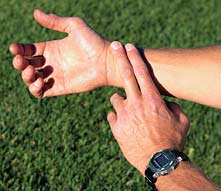It’s happening – the earth is shaking. Furniture is dancing across the room, you’re under a table and hanging on (right?), and all you can hear is rumbling. You’re probably not feeling particularly calm. In fact, your heart feels like it’s racing a mile a minute. First responders call this the adrenaline dump. Here’s what can happen to your body when your heart increases.
Effects of Hormonal Induced Heart Rate Increase
- 60-80 BPM: Normal resting heart rate, normal body function.

- 115 BPM: Fine motor skills begin to deteriorate.
- 115 to 145 BPM: Optimal survival and combat performance level for complex motor skills, visual reaction time, and cognitive reaction time.
- ABOVE 145 BPM: Complex motor skills begin to deteriorate.
- 175 BPM: Cognitive processing deteriorates; vasoconstriction (reduced bleeding from wounds); loss of peripheral vision (tunnel vision); loss of depth perception; loss of near vision; auditory exclusion (tunnel hearing).
- ABOVE 175 BPM: Irrational fighting or fleeing; freezing; submissive behavior; voiding of bladder and bowels; gross motor skills (running, charging, etc.) at highest performance level.
This data is for hormonal induced heart rate increases resulting from sympathetic nervous system arousal. Exercise induced increases will not have the same effect. – 1997 Siddle and Grossman
Tactical Breathing to Slow Heart Rate
Tactical or “combat” breathing is a technique used by military, police, and other first responders to slow heart rate and regain normal biochemical functioning.
HERE’S HOW TO DO IT:
- Breathe in through your nose to the count of 4.
- Hold your breath to the count of 4.
- Breathe out through your lips to the count of 4.
- Hold your breath to the count of 4.
- Repeat until you feel your body and mind relax.
Vary the number of counts to match your body’s ability and comfort level.
USE IT IN EVERYDAY LIFE:
This technique can be useful without practice, but you’re much more likely to use it in a stressful situation if you practice it regularly. Do it before a job interview. Do it during rush hour traffic. Do it after a stressful encounter to help you calm down. The more you do it, the more likely you are to remember it when you need it most.
–Laura Hall, Arbor Lodge / Kenton NET Assistant Team Leader, arborlodgeprepares@gmail.com
